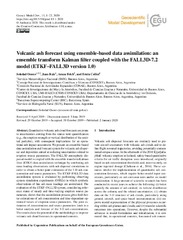Mostrar el registro sencillo del ítem
Volcanic ash forecast using ensemble-based data assimilation: an ensemble transform Kalman filter coupled with the FALL3D-7.2 model (ETKF–FALL3D version 1.0)
| dc.contributor.author | Osores, María Soledad | |
| dc.contributor.author | Ruiz, Juan José | |
| dc.contributor.author | Collini, Estela Ángela | |
| dc.date.accessioned | 2020-01-24T15:24:52Z | |
| dc.date.available | 2020-01-24T15:24:52Z | |
| dc.date.issued | 2020-01 | |
| dc.identifier.citation | Osores, S., Ruiz, J., Folch, A., and Collini, E.: Volcanic ash forecast using ensemble-based data assimilation: an ensemble transform Kalman filter coupled with the FALL3D-7.2 model (ETKF–FALL3D version 1.0), Geosci. Model Dev., 13, 1–22, https://doi.org/10.5194/gmd-13-1-2020, 2020. | es |
| dc.identifier.issn | 2193-0856 | |
| dc.identifier.uri | http://hdl.handle.net/20.500.12160/1265 | |
| dc.identifier.uri | https://doi.org/10.5194/gmd-13-1-2020 | |
| dc.description.abstract | Quantitative volcanic ash cloud forecasts are prone to uncertainties coming from the source term quantification (e.g., the eruption strength or vertical distribution of the emitted particles), with consequent implications for an operational ash impact assessment. We present an ensemble-based data assimilation and forecast system for volcanic ash dispersal and deposition aimed at reducing uncertainties related to eruption source parameters. The FALL3D atmospheric dispersal model is coupled with the ensemble transform Kalman filter (ETKF) data assimilation technique by combining ash mass loading observations with ash dispersal simulations in order to obtain a better joint estimation of the 3-D ash concentration and source parameters. The ETKF–FALL3D data assimilation system is evaluated by performing observing system simulation experiments (OSSEs) in which synthetic observations of fine ash mass loadings are assimilated. The evaluation of the ETKF–FALL3D system, considering reference states of steady and time-varying eruption source parameters, shows that the assimilation process gives both better estimations of ash concentration and time-dependent optimized values of eruption source parameters. The joint estimation of concentrations and source parameters leads to a better analysis and forecast of the 3-D ash concentrations. The results show the potential of the methodology to improve volcanic ash cloud forecasts in operational contexts. | eng |
| dc.language.iso | eng | |
| dc.publisher | Geoscientific Model Development | es |
| dc.subject | VOLCANIC ASH FORECAST | es |
| dc.subject | DATA ASSIMILATION | es |
| dc.subject | KALMAN FILTER | es |
| dc.subject | ETKF–FALL3D | es |
| dc.title | Volcanic ash forecast using ensemble-based data assimilation: an ensemble transform Kalman filter coupled with the FALL3D-7.2 model (ETKF–FALL3D version 1.0) | es |
| dc.type | Artículo | es |
